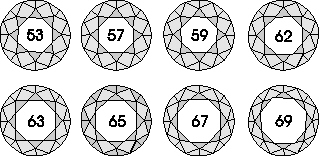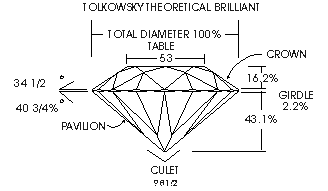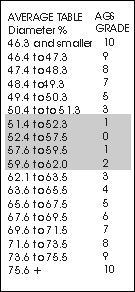|
The table is the large flat facet on the
crown or top of a diamond. The table directly
affects scintillation, or sparkle in a diamond.
The combination of table size and crown
angle governs the balance between brilliance,
flashes of white light returning to the
eye from within the diamond, and dispersion,
the play of spectral colors seen by the
eye created by refracted light as it prisms
through a diamond's facets.
 Research
indicates that it is better to select a
round brilliant cut diamond that has a table
percentage between 53 and 62%. Diamonds
with table percentages between this range
deliver greater brilliance and are considered
to have very fine-ideal cut. The following
offers you information to support this position. Research
indicates that it is better to select a
round brilliant cut diamond that has a table
percentage between 53 and 62%. Diamonds
with table percentages between this range
deliver greater brilliance and are considered
to have very fine-ideal cut. The following
offers you information to support this position.
Tolkowsky
Theoretical Ideal Cut
 The
Tolkowsky theoretical brilliant cut is a
standard of proportions and facet angles
that were calculated by Marcel Tolkowsky
in 1919. The Tolkowsky theoretical model
presents 53% as ideal table percentage.
Today, highly respected gemological institutions
endorse standards that include variations
from the Tolkowsky model. The
Tolkowsky theoretical brilliant cut is a
standard of proportions and facet angles
that were calculated by Marcel Tolkowsky
in 1919. The Tolkowsky theoretical model
presents 53% as ideal table percentage.
Today, highly respected gemological institutions
endorse standards that include variations
from the Tolkowsky model.
Two highly
respected gemological institutions have
published systems for grading diamond cut:
the Gemological Institute of America (GIA),
and the American Gem Society (AGS). These
highly respected gemological institutions
have developed systems for classifying
cut quality.
GIA's
system as outlined in GIA's diploma study
course uses this four class system:
-
Class
1 = Ideal
-
Class 2 = Fine
-
Class 3 = Fair
-
Class 4 = Poor
The AGS (American Gem Society) standards
for Table Percentage.
 The
AGS system uses a 0 to 10 system: Cut grade
0 as Ideal, 2 as Very Fine and 10 being
the lowest grade and quality. The AGS cut
grade 0 ideal endorses table percentages
between 51.6% to 57.5% as ideal with 57.6
to 62% as very fine AGS cut 2. The
AGS system uses a 0 to 10 system: Cut grade
0 as Ideal, 2 as Very Fine and 10 being
the lowest grade and quality. The AGS cut
grade 0 ideal endorses table percentages
between 51.6% to 57.5% as ideal with 57.6
to 62% as very fine AGS cut 2.
There are
slightly more very fine cut diamonds available
with table sizes that are slightly over
60%. To say that diamonds with table percentages
under 60% are only acceptable is like saying
D - flawless is the only acceptable choice
in regards to a diamonds color and clarity
grades. As a Certified-Gemologist Appraiser,
I have examined many very fine cut diamonds
with table percentages which vary slightly
from perfect ideal. These diamonds also
display extreme brilliance.
Unlike strict
ideal cut, selecting a diamond that has
very fine cut offers the option of greater
savings and more diamond choices. Today
only a few diamond cutters cut diamonds
with rare table percentages under 58%. In
contrast, there are slightly more diamonds
available cut with table percentages between
59% and 62%. Diamonds in this range also
display extraordinary brilliance. AGS cut
grade 2 (very fine) includes diamonds with
table percentages up to 62%. The great majority
of diamonds sold today have table percentages
much higher than 62%. To select a diamond
that has a table percentage under 62% ensures
you have chosen a diamond that is very fine
in cut quality with regards to table percentage.
The Gemological
Institute of America announce a 59% table
produces greater brilliance.
GIA's
conclusion was based on evidence provided
by a new three-dimensional computer ray
tracing instrument. Fine cut diamonds that
have table sizes below 62% cost more because
a larger portion of the rough diamond is
sacrificed to cut ideal proportions
Bill
Boyajian, President of the Gemological Institute
of America shares information regarding
ideal table size.
Research indicates that table sizes that
are under 62% deliver exceptional brilliance.
Diamonds with table sizes under 59% create
slightly greater dispersion of light which
results in the emission of slightly more
spectral colors. Diamonds with table sizes
that are 59%, or slightly higher, offer
the viewer greater amount of brilliance,
or white light returning to the eye. When
table size is lower, dispersion increases
and brilliance is lowered. When table size
is higher, brilliance increases and dispersion
is lowered. Because beauty is determined
by the eye of the beholder, it is unlikely
that a specific table percentage will be
absolutely defined by GIA. Research indicates,
and Gemologists agree that diamonds with
table measurements under 62% have superior
brilliance and dispersion. Diamonds in these
ranges usually require that the diamond
cutter cut away more diamond weight in order
to achieve this higher quality of brilliance.
The brilliance
of your diamond depends on proper cutting.
Our Certified Gemologist-Appraisers select
only ideal to premium cut diamonds to ensure
that the diamond you choose will be as brilliant
as it is beautiful. A diamond with these
premium proportions will cost more but its
brilliance is well worth the added investment. |